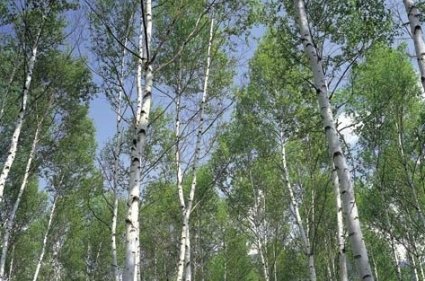Six Trees to Plant in the Northwest to Attract Birds
If you're an avian enthusiast, you likely keep at least one or two feeders and a ready supply of water to attract you local feathered friends. However, if you really want to create a bustling year-round habitat that will
draw an active assortment of birds, planting a few well-chosen trees is a good way to go. These six trees are great Northwest choices for livening up your backyard.
1. Birch (Betula)
This large group of deciduous shrubs and trees offers attractive, nectar-laden flowers during the spring (popularly known as catkins), and plentiful seeds in late autumn. These dense-packed grains are irresistible to many small perching birds, including redpolls, chickadees, and pine siskins. Depending on the variety, birches can grow to heights ranging from 3 to 70 feet.
2. Beech (Fagus)
Beech trees are on the medium to small size. After flowering in the spring, they quickly develop prickly fruits containing small brown nuts that make excellent feeding for birds that overwinter locally. Species that enjoy beechnuts include warblers, titmice, chickadees, nuthatches, jays, and some types of woodpecker. Beeches will reach between 20 and 100 feet, and some varieties can even be trimmed to form handsome hedges.
3. Horse Chestnut (Aesculus hippocastanum)
The horse chestnut is another deciduous tree that makes a spectacular show of nectar-rich blossoms early in the year, followed by huge palm-shaped leaves that provide ample shelter for birds to perch, nest, and feed in safety. In the fall, the horse chestnut produces a leathery fruit containing nutrient-rich, nutlike seeds. This tree prefers full sun, and grows 30 to 75 feet.
4. Magnolia (Magnolia)
Magnolia trees come in evergreen and deciduous varieties, and can be identified instantly by their dramatic white-to-mauve springtime blooms and thick, waxy leaves. In the late summer, magnolias offer beautiful cone-shaped clusters of bright red seeds that bring in larger perching birds like sapsuckers, vireos, and woodpeckers. Magnolia species enjoy full-sun to partial shade conditions, and reach mature heights between 10 and 80 feet.
5. Redbud (Cercis)
This popular deciduous ornamental offers a breathtaking profusion of magenta-hued flowers in the spring that lead to reddish-brown, beanlike pods that last well into winter. These pods provide a nutrition-packed treat to chickadees, nuthatches, and many other seed-loving birds. Redbuds grow well under full sun and light-shade conditions, and reach heights between 10 and 35 feet.
6. Maple (Acer)
From native vine varieties to bright-colored sugar maples and distinctive Japanese ornamentals, maple trees and shrubs produce a plethora of small, winged nuts relished by robins, warblers, vireos, wrens, finches, and many other birds. Depending on the species, mature maple trees can reach heights between 15 and 35 feet.
 How Chameleon Trucking Companies are a Threat
How Chameleon Trucking Companies are a Threat
 Why Is High Cholesterol Common in Children?
Why Is High Cholesterol Common in Children?

 webforjason
webforjason